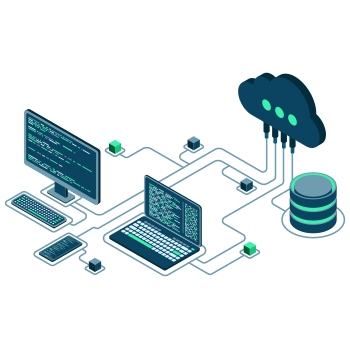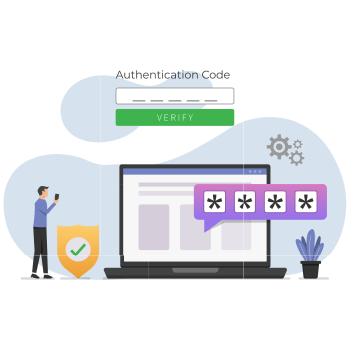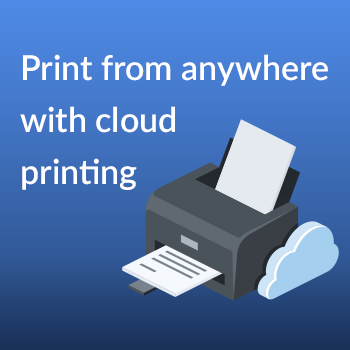Cloud printing is a printing solution that enables users to send print jobs to printers connected to a cloud service, regardless of their physical location. Unlike traditional printing methods that rely on a direct connection between a computer and a printer, cloud printing uses the internet and leverages cloud infrastructure to streamline your printing process.

Cloud printing relies on a network of interconnected devices, including computers, printers, and servers, to facilitate printing tasks. The infrastructure involves cloud-based print servers and specialized software that coordinates the communication between your user's device and the printer. What are the key components and their roles?
Cloud printing allows users to print documents from anywhere with an internet connection. Users can send print jobs remotely, eliminating the need to be physically present near the printer. This convenience is particularly useful for mobile professionals, remote teams, or users on the go.
Cloud printing eliminates the need for complex printer installations and driver configurations on each user's device. With cloud-enabled printers, admins can easily connect users’ printers to the cloud print server and manage them remotely.
Cloud printing facilitates seamless collaboration among team members. Multiple users can share access to the same cloud-enabled printer, streamlining document workflows. Users can collaborate on documents, make edits, and then print the final versions, promoting efficient teamwork and productivity.
Cloud printing can lead to significant cost savings for businesses. It reduces the need for maintaining multiple printers in different locations, as users can access a centralized pool of cloud-enabled printers. This consolidation optimizes printer utilization and minimizes unnecessary hardware purchases. Additionally, cloud printing reduces paper waste through features such as print release, where users authenticate themselves at the printer before their document is printed.
Choosing the Right Cloud Printing Service Provider
When implementing cloud printing, it's crucial to select a reputable and reliable cloud printing service provider. Consider factors such as their infrastructure reliability, security measures, compatibility with existing systems, and technical support capabilities. Evaluating customer reviews and requesting demonstrations can also help in making an informed decision.
Integration with Existing Infrastructure Ensure compatibility between the cloud printing solution and your existing IT infrastructure. Evaluate whether the cloud printing system integrates smoothly with your network, operating systems, and existing print management software. This compatibility ensures a seamless transition and reduces potential disruptions.
Security Considerations
Protecting sensitive information is paramount when implementing cloud printing. Verify that the cloud printing service provider implements robust security measures, such as encryption, user authentication, and secure transmission protocols. Regularly update passwords, restrict access to authorized users, and implement secure printing features to prevent unauthorized access to printed documents.
User Training and Adoption
To maximize the benefits of cloud printing, provide comprehensive training to users on how to initiate print jobs, manage print queues, and utilize advanced features. Encourage user adoption by highlighting the convenience and productivity gains. Address any concerns or questions promptly to ensure a smooth transition.

Data transmitted between the user's device, the cloud print server, and the printer should be encrypted to protect it from unauthorized access. Encryption protocols, such as SSL/TLS, should be implemented to secure data in transit.

Implement strong user authentication mechanisms to prevent unauthorized access to print jobs and printer settings. Users should be required to authenticate themselves before initiating print jobs or accessing sensitive print management functions.

Control access to cloud printing resources, such as printers and print queues. Only authorized users should have permission to send print jobs, manage print queues, and access sensitive printer settings.
Data Privacy and Security
Storing and transmitting data over the internet can raise concerns about data privacy and security. To mitigate these risks, choose a cloud printing service provider with robust security measures in place. Regularly update software and firmware to address vulnerabilities and comply with relevant data protection regulations.
Reliability and Uptime
Reliable internet connectivity is crucial for cloud printing to function seamlessly. Network outages or slow connections can disrupt print jobs and hinder productivity. Consider implementing backup solutions or redundant internet connections to minimize downtime.
Bandwidth and Network Requirements
Cloud printing relies on internet bandwidth to transmit print jobs. Ensure your network infrastructure can handle the increased data traffic generated by cloud printing. Evaluate network bandwidth requirements and consider upgrading network resources if necessary.
Compatibility and Integration with Legacy Systems
When integrating cloud printing into an existing IT ecosystem, compatibility with legacy systems becomes essential. Evaluate the compatibility of your printers, operating systems, and software with the cloud printing solution. If needed, consult with IT professionals to ensure smooth integration and minimal disruptions.

Cloud printing has revolutionized the way we approach printing tasks, offering increased accessibility, simplified setup, enhanced collaboration, and cost savings. By leveraging the power of the internet and cloud infrastructure, businesses and individuals can streamline their printing workflows and achieve greater efficiency. No matter how you’re deploying virtual desktops and where your print jobs are originating from, Tricerat has you covered.
Experience the power of ScrewDrivers, Tricerat's cutting-edge print management software designed to centralize and simplify your printing environment. With our intuitive drag-and-drop console, your administrators can effortlessly assign the right printers to the right users, streamlining the entire process. But that's not all—our best-in-class virtual print driver revolutionizes the way you handle driver compatibility, ensuring that compatibility issues become a thing of the past. Ready to get started on your cloud printing journey? Contact us today.